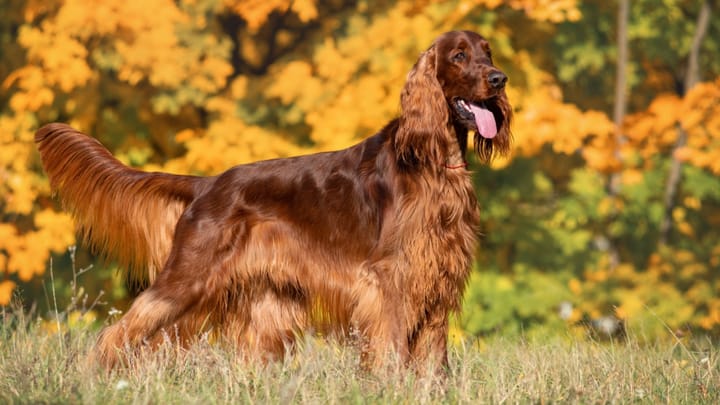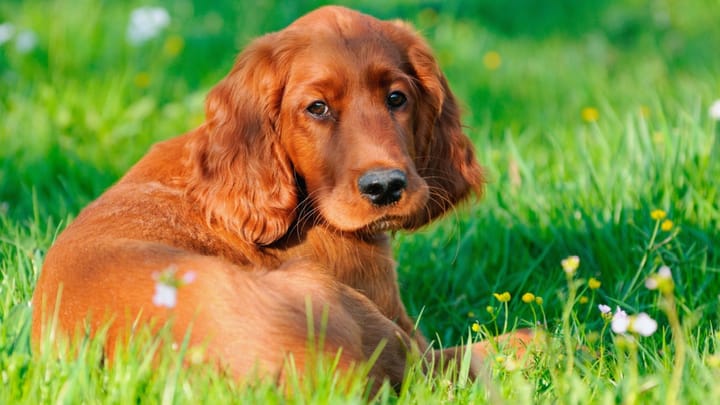Irish Red Setter
Other names : Red Setter, Irish Setter


Originating in Ireland, Irish Setters first appeared as gundogs. Their popularity soon spread, not only because of their enthusiasm as working bird dogs, but also because of their stunning, mahogany coats. This breed is very friendly and excel in many activities and canine sports. With a high energy drive, this dog is quite boisterous and bold too. He loves anything to do with sporting birds and has a strong hunting instinct.
|
Life expectancy |
The Irish Red Setter has a life expectancy of between 12 and 14 years |
|
Temperament |
|
|
Size |
Medium
|
|
Adult size |
Female
Between 22 and 24 in
Male
Between 23 and 26 in
|
|
Adult weight |
Female
Between 40 and 51 lb
Male
Between 44 and 55 lb
|
|
Coat colour
The coat colour ranges from mahogany to a deep, chestnut red shade. Often a small amount of white on the dog’s chest. |
Red White |
|
Type of coat
Long for the Irish red and white Setter and mid length for the Irish Red Setter. The coat is short around the head, medium length on the dog’s body with longer feathering on the chest, belly, back of the legs and the ears. |
Long |
|
Eye colour
Brown to dark. |
Brown
|
|
Purchase price |
The Irish Red Setter costs between £810 and £860 |
These good-looking, Irish Setter dogs are a very popular breed, not only in the UK, but worldwide too. This means that puppies from established breeders can be sold to a high price. As with all types of dogs, when choosing a new puppy:
- Beware of scams online selling and advertising puppies. These false sellers might show you fake images of gorgeous Irish Setter pups they are selling, at budget prices. Always visit the breeders home before you commit to buying a puppy, or you hand over any money.
- Be aware also, that some amateur breeders choose to breed from a female dog too many times, which is not only very cruel but also means that the resulting pups may not be in the best of health.
- When deciding to buy an Irish Setter puppy, always ask to see details of the dog’s lineage, proof of their vaccinations and microchipping.
More details about the Irish Red Setter
Irish Red Setter: Origins and history
The Irish Setter, as his name suggests, comes from Ireland. The breed was developed there during the 18th century, when Gordon Setters, Pointers, Spaniels and English Setters were likely combined. Some of the first of the breed were known as Red Spaniels, or the Gaelic version of red dog, “Modder Rhu”. Many setters with either solid red coats or red sprinkled with tiny white dots were bred during this time.
The first Irish Setter imported from Ireland to the United States in 1875 was named Elcho. This famous dog was a star, not only in the hunting field but also in the show ring. Likewise, in 1878, Admiral was the first of the breed to be registered by the American KC. During the 60’s and 70’s, popularity rose for this breed of dogs, notably due to Big Red, a famous Irish Setter who had a movie and books named after him. The dog’s popularity remains stable in present times.
Physical characteristics of the Irish Red Setter
This active dog has a long, lean head shape, with an oval, domed skull shape. The dog’s body is longer than it is tall. His nose is either brown or black. Almond-shaped eyes are set wide apart on the dog’s face. Thin, low-set ears are triangular shaped. The dog has straight front legs and a long tail, quite thick, that tapers to a point at the end. With a shiny, usually mahogany or deep red coloured coat, with feathering that is longer in appearance. Some young dogs can have a silver-grey shade hair behind the legs and ears, however as the dog grows, this usually disappears.
FCI classification of the Irish Red Setter
-
Group 7 - Pointing Dogs
-
Section 2 : British and Irish Pointers and Setters
Irish Red Setter: Varieties
- Irish Red Setter
- Irish Red and White Setter
Irish Red Setter: Characteristics
Irish Red Setter: Behaviour
Training a Irish Red Setter
Certainly, Irish Setters are very responsive to training, however, often quite mischievous. As he loves to spend time around people, he will enjoy the extra time you spend on training sessions. Very capable of learning many skills including complex and advanced ones, especially if you begin these routines from puppyhood.
Irish Red Setter: Lifestyle
Breed compatibility Irish Red Setter
Irish Red Setter: Purchase price
The average price of an Irish Setter dog in the UK, is £860 for a dog registered at the Kennel Club and £810 for a dog that isn’t.
As a rough guide, the cost to feed, insure and care for an Irish Setter, including annual veterinary check-ups, will be around £80 to £100 each month. This however, does not include the initial buying cost of your pet.
Irish Red Setter: Shedding
Average
This breed is known for its glamorous and shiny, deep mahogany coat, but yes, they do shed hair. Regular grooming and brushing will keep the dog’s coat in great condition, and also keep the shedding hair under control.
Irish Red Setter: Grooming
Regular brushing is needed to keep the Irish Setter’s coat tangle-free and shiny. When he’s been out on a walk, check for debris that can attach itself to his feathering. A bi-annual bath should suffice, unless of course, he rolls in something really smelly. Care should be taken with his ears to keep them clean and free from infections.
Irish Red Setter: Health
As fairly healthy dogs, providing there are no unexpected health conditions, they will live to between 12 and 14 years on average.
If you take into account that this is a hunting breed, who can run over rough terrain for many hours, he is certainly a robust dog.
As a hunting dog that is bred to spend most of his time in the sporting field, he loves being outside, no matter the weather. Saying this, however, he is also quite happy to spend time indoors, especially if this involves playful activities with his family.
The Irish Setter is happy to spend lots of time hunting and exercising outside, in all chilly weathers. Likewise, he loves nothing better than to dive into water for a swim, even though the water may be cold!
As a very agile and energetic canine, providing adequate exercise is offered, the dog won’t easily put on any excess weight.
Health conditions that affect this breed of dog are:
- Hip dysplasia
- Epilepsy
- Rickets
- Bloat
- Progressive retinal atrophy
- Reproduction issues
- Wheat sensitive allergies








